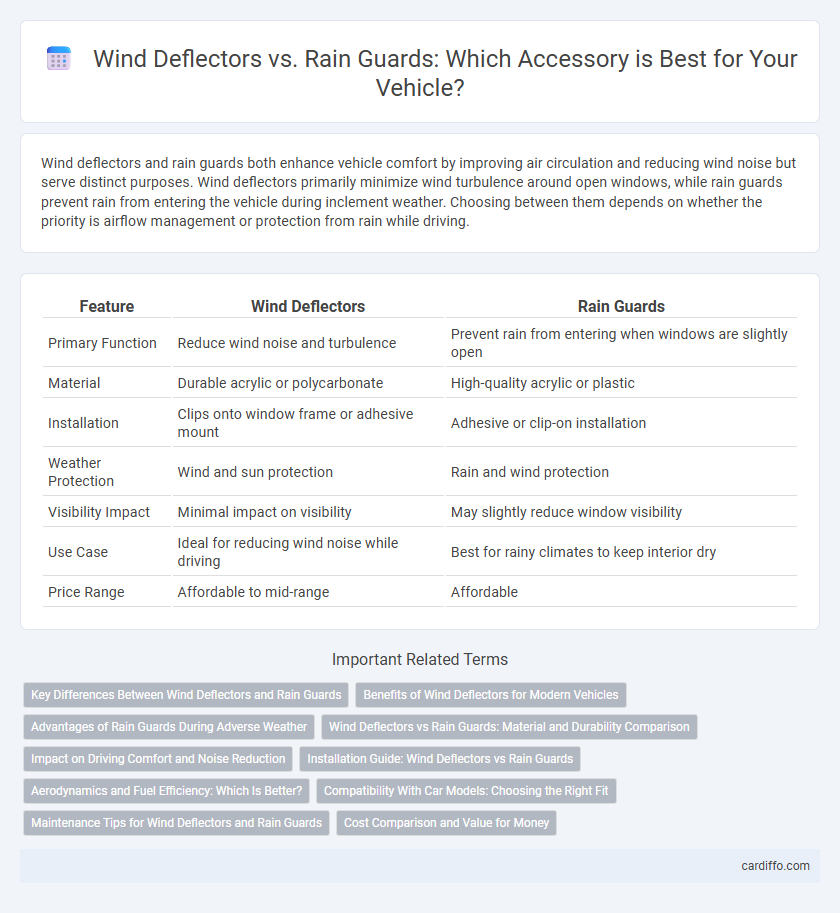Wind deflectors and rain guards both enhance vehicle comfort by improving air circulation and reducing wind noise but serve distinct purposes. Wind deflectors primarily minimize wind turbulence around open windows, while rain guards prevent rain from entering the vehicle during inclement weather. Choosing between them depends on whether the priority is airflow management or protection from rain while driving.
Table of Comparison
| Feature | Wind Deflectors | Rain Guards |
|---|---|---|
| Primary Function | Reduce wind noise and turbulence | Prevent rain from entering when windows are slightly open |
| Material | Durable acrylic or polycarbonate | High-quality acrylic or plastic |
| Installation | Clips onto window frame or adhesive mount | Adhesive or clip-on installation |
| Weather Protection | Wind and sun protection | Rain and wind protection |
| Visibility Impact | Minimal impact on visibility | May slightly reduce window visibility |
| Use Case | Ideal for reducing wind noise while driving | Best for rainy climates to keep interior dry |
| Price Range | Affordable to mid-range | Affordable |
Key Differences Between Wind Deflectors and Rain Guards
Wind deflectors reduce wind noise and turbulence by redirecting airflow around open windows, enhancing driving comfort without significant weather protection. Rain guards, also called rain visors, primarily prevent rain and moisture from entering the vehicle while allowing windows to remain slightly open, improving ventilation during wet conditions. The key difference lies in wind deflectors focusing on airflow management, while rain guards emphasize weather shielding.
Benefits of Wind Deflectors for Modern Vehicles
Wind deflectors enhance aerodynamics by reducing wind noise and drag, improving fuel efficiency for modern vehicles. They offer ventilation benefits, allowing fresh air circulation without letting rain or debris enter the cabin. These accessories also increase driving comfort by minimizing wind turbulence and protecting occupants from harsh weather conditions.
Advantages of Rain Guards During Adverse Weather
Rain guards provide enhanced protection against rain by preventing water from entering the vehicle when windows are slightly open, improving ventilation without compromising comfort. They reduce wind noise and minimize fogging on windows, ensuring clearer visibility during storms. These features make rain guards a superior choice for maintaining cabin dryness and safety in adverse weather conditions.
Wind Deflectors vs Rain Guards: Material and Durability Comparison
Wind deflectors are typically made from high-quality acrylic or polycarbonate, offering excellent UV resistance and long-lasting durability against harsh weather conditions. Rain guards often use similar materials but may incorporate additional sealing features to prevent water intrusion, enhancing their effectiveness during heavy rain. Both accessories provide robust protection, but wind deflectors prioritize aerodynamic performance while rain guards focus on superior water resistance and durability.
Impact on Driving Comfort and Noise Reduction
Wind deflectors and rain guards both enhance driving comfort by minimizing wind turbulence and water intrusion through partially opened windows. Wind deflectors excel in reducing wind noise at higher speeds, creating a quieter cabin environment, while rain guards primarily prevent rain from entering the vehicle without significantly affecting sound levels. Choosing the ideal accessory depends on the driver's preference for noise reduction versus weather protection during ventilation.
Installation Guide: Wind Deflectors vs Rain Guards
Wind deflectors typically require adhesive tape or clips for secure installation on car windows, ensuring a snug fit that minimizes wind noise. Rain guards often utilize a similar clip-on method but may include extra seals to prevent water infiltration, enhancing protection during storms. Proper alignment and surface cleaning are essential steps for both accessories to maximize durability and effectiveness.
Aerodynamics and Fuel Efficiency: Which Is Better?
Wind deflectors are designed to reduce air resistance by streamlining airflow around the windows, which can enhance a vehicle's aerodynamics and potentially improve fuel efficiency. Rain guards primarily focus on preventing water from entering the cabin without significantly impacting air flow, resulting in minimal effect on aerodynamics or fuel economy. For drivers prioritizing fuel savings and aerodynamic performance, wind deflectors offer a more effective solution compared to rain guards.
Compatibility With Car Models: Choosing the Right Fit
Wind deflectors and rain guards vary significantly in compatibility across different car models, with each accessory designed to fit specific window shapes and sizes. Ensuring precise measurements and selecting products tailored to the make and model of your vehicle guarantees optimal functionality and a secure fit. Manufacturer specifications and customer reviews provide valuable insights into compatibility, helping to avoid issues like poor sealing or aerodynamic inefficiency.
Maintenance Tips for Wind Deflectors and Rain Guards
Regular cleaning of wind deflectors and rain guards with mild soap and water prevents buildup of dirt and debris that can cause damage or reduce visibility. Inspect these accessories frequently for cracks or loose fittings and tighten or replace hardware to maintain optimal performance. Applying a UV protectant helps extend the lifespan of materials exposed to sunlight, preserving both appearance and functionality.
Cost Comparison and Value for Money
Wind deflectors typically cost less than rain guards, making them a budget-friendly option for those seeking basic protection against wind noise and air turbulence. Rain guards, while more expensive, offer superior weather protection by preventing rain from entering through partially open windows, adding significant value in regions with frequent precipitation. Evaluating long-term durability and functionality, rain guards generally provide better value for money despite the higher initial investment.
Wind Deflectors vs Rain Guards Infographic

 cardiffo.com
cardiffo.com